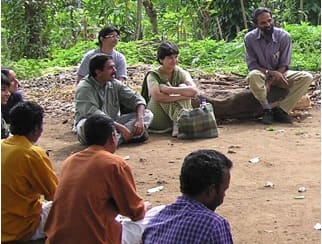
Biocultural diversity
A long-term sustainable and mutually beneficial relationship with their life environment characterizes the existence of many indigenous peoples and local communities.[1] Such inextricable link between their cultural diversity and biological diversity was framed by Darrel Posey under the term ‘biocultural diversity’. Based on Posey’s work, the Code of Ethics of the International Society of Ethnobiology defines biocultural heritage as “the cultural heritage (both tangible and intangible, including customary law, folklore, spiritual values, knowledge, innovations and practices) and biological heritage (diversity of genes, varieties, species and ecosystem provisioning, regulating, and cultural services) of Indigenous Peoples, traditional societies and local communities”. It further recognises that the cultural and biological heritage “are inextricably linked through the interaction between peoples and nature over time and shaped by their socioecological and economic context”.
The term ‘biocultural diversity’ denotes the idea that “maintaining and restoring the diversity of life means sustaining both biodiversity and cultures, because the two are interrelated and mutually supportive”.[2] Collectively held and transmitted from one generation to the next, biocultural diversity is the foundation and essential feature that makes ICCAs—territories of life possible. The very role of indigenous peoples and local communities as custodians of their life environment is entrenched in the existence of biocultural diversity, the diverse governance and management practices and institutions that sustainably use and conserve nature in the long-term (see Sustainable use #Conservation #Sustainable self-determination).
Key references:
Posey (ed.), 1999; Borrini-Feyerabend, MacDonald and Maffi, 2004; Maffi, 2007; Maffi and Woodley, 2010; Kothari et al., 2012; Wilson, 2016; First North American Dialogue on Biocultural Diversity, 2019.
See also: IIED page on Cultural Heritage; International Society of Ethnobiology
[1] Garnett et al., 2018; Corrigan et al., 2018.
[2] Maffi, 2007, page 1. See also Borrini-Feyerabend,MacDonald and Maffi, 2004 and First North American Dialogue on Biocultural Diversity, 2019.